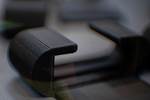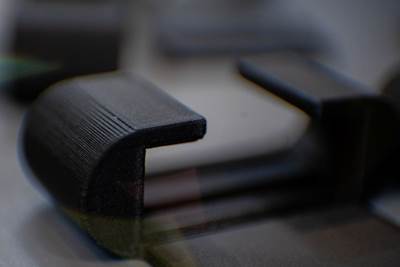EOS Additive Minds Academy Opens Space for Hands-On AM Training
The engineering, consulting and education arm of EOS has offered training in various capacities before now, but a new physical footprint at the company’s Novi, Michigan, facility will make AM training more accessible and affordable.
EOS opened its Additive Minds Academy space in Novi with a ribbon cutting on August 1. Glynn Fletcher (third from left, EOS North America president) and Fabian Alefeld (third from right, senior manager of the Academy and consulting efforts) both provided commentary on the occasion.
Technology supplier EOS has opened a training facility in North America for Additive Minds, its engineering, consulting and education arm. The company first launched this initiative in 2016, recognizing a need for on-demand expertise and training in additive manufacturing (AM).
“AM was accelerating toward production, but the workforce to support that growth was nonexistent,” says Fabian Alefeld, EOS senior manager of the Additive Minds Academy and consulting services.
Formed from some of the company’s most experienced engineers, Additive Minds has helped to cultivate that workforce within EOS customers over the last eight years, primarily through on-site workshops, co-engineering projects and various trainings. But now, that training has its own centralized location in North America at the EOS facility in Novi, Michigan, with the opening of the Additive Minds Academy on August 1, 2024.
One advantage of the Academy facility is the close proximity of lab and lecture space, Alefeld says. Students can learn about AM aspects such as DFAM or build preparation in this classroom area, and then practice hands-on skills in the laboratories beyond the glass doors.
The Academy occupies one end of EOS’ 15,000-square-foot Michigan facility, and consists of dedicated classroom space as well as two labs — one for laser powder bed fusion (LPBF) of metals, which holds a single-laser M290 as well as a four-laser M400-4 also equipped with build-swap capability and a Grenzebach depowdering unit; and one for polymers, with the company’s P-series selective laser sintering (SLS) machines in three sizes. While these labs sometimes provide benchmarking or overflow services for customers and other EOS locations, their primary role is to serve as hands-on learning spaces.
Additive Minds also encompasses online courses and certifications, and has always provided hands-on training within customer facilities. But the introduction of a dedicated physical location makes sense for several reasons, Alefeld says:
- Cost savings. Hands-on training has always been a part of EOS’ work with customers, but previously that training usually took place at a customer facility. It might cost a customer $10,000 to pay for a trainer to come to their facility and spend a week. Scaling instructor on-site training is also difficult because serving more customers meant hiring and training more trainers. Consolidating its training capacity into one place at the Academy, in a central Midwest location, now enables the company to offer classroom training at lower cost, more in the neighborhood of a few thousand dollars per person.
- Standardization. Part of the cost savings comes from avoiding the need to adapt instruction to user facilities, and instead teaching operators with standard equipment, using a consistent procedure. “It’s often the case in additive that people get trained by someone who got trained by someone who got trained by someone else,” Alefeld says. “There’s a trickle-down effect,” he explains, that can water down the content over time. With a dedicated facility, the same trainers can give more consistent training on known equipment. It’s also a chance for instructors to learn from each other, and feed their knowledge back into the curriculum whether on-site or online. “We can standardize and digitize,” Alefeld says.
- Minimized disruption. Leading additive manufacturing training inside a customer facility has become increasingly challenging as the technology has matured and applications have advanced into production. Where previously such training might only interrupt the flow of prototypes through a lab, today it could mean taking a production machine offline for days in a row — an added expense on top of the cost of the training. Sending trainees elsewhere allows AM users to continue making parts in their absence, and, as a side benefit, minimizes distractions to the employee because they are less likely to get pulled away for meetings and other duties while completing the training.
- Networking and other soft benefits. While customers can choose to book custom courses with only their operators, in most cases training is open to anyone who signs up through the Additive Minds website. Cohorts are often made up of people from noncompetitive sectors who end up learning from and networking with each other. The barrier to entry is lower as well; courses can be booked and paid for online, with no need to own or operate a printer already.
- Stronger industry and local collaborations. EOS-led training will not necessarily fill all the capacity of the Additive Minds Academy space. So, the company is offering time and resources to other organizations that need hands-on facilities. ASTM now runs its LPBF certification courses at the location, and soon Project DIAMOnD (the initiative that placed more than 300 desktop printers at Michigan manufacturers in 2020) will also use the space to provide additional training to its members. As EOS North America President Glynn Fletcher stated in his opening remarks, the facility aims “to provide training that can allow everybody to become more successful.”
The Additive Minds Academy includes this lab for metal laser powder bed fusion, as well as a polymer lab for selective laser sintering beyond the far doors.
“It was the right move,” Alefeld says of the decision to open this physical space. While the ribbon cutting and official opening happened August 1, EOS has been using the Academy facility for training since the spring. Feedback so far has been positive from students and their companies as well as instructors.
The Novi location complements an existing Additive Minds training facility in Germany. And Additive Minds Academy is, and will continue to be, digital as well, with five online certificate programs as well as other digital resources. The company for example offers a university-focused program that provides its entire online curriculum to students for free, supplemented by EOS guest lectures and additional support.
Related Content
8 Cool Parts From Formnext 2023: The Cool Parts Show #65
New additive manufacturing technologies on display at Formnext were in many cases producing notable end-use components. Here are some of the coolest parts we found at this year’s show.
Read More3D Printed Polymer EOAT Increases Safety of Cobots
Contract manufacturer Anubis 3D applies polymer 3D printing processes to manufacture cobot tooling that is lightweight, smooth and safer for human interaction.
Read MoreFormlabs’ Form 4L, 4BL Designed for Reliable, High-Speed SLA 3D Printing
Other innovations include the Developer Platform which offers flexibility and control to unlock new workflows, applications and material options; and additional printer accessories, SLS materials, PreForm features and postprocessing solutions to empower users with more scale, throughput, affordability and performance.
Read MoreCoreTechnologie Optimizes AI-Supported 3D Nesting Software for Higher Efficiency
The new version of the universal 3D printing software 4D_Additive 1.6 features an AI-supported nesting technology, which enables an average 30% increase in efficiency when operating SLS and MJF printers compared to the previous version and other common nesting tools.
Read MoreRead Next
4 Ways the Education and Training Challenge Is Different for Additive Manufacturing
The advance of additive manufacturing means we need more professionals educated in AM technology.
Read MoreIs a Functional 3D Printer Network Possible? Automation Alley’s Project DIAMOnD and the Industry 4.0 Future
The initiative that placed 3D printers at more than 300 Michigan manufacturers is laying the groundwork for a future in manufacturing that is digital, distributed and largely additive.
Read MoreAM Workshop at IMTS: Succeeding With Powder Bed Fusion
A half-day event at the International Manufacturing Technology Show focuses on tactics for success for machine shops and other manufacturers preparing to embrace production 3D printing via powder bed fusion.
Read More
.jpg;width=70;height=70;mode=crop)






















